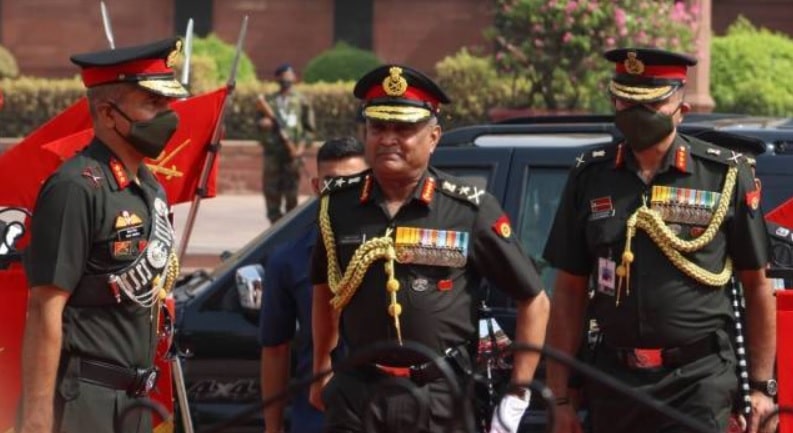What’s in today’s article?
- Why in news?
- News Summary: Indian Army introducing common uniforms for officers of brigadier rank and above
- What will change?
- What has been the current practice?
- What is the reason for making the change?
- Is this the first time that this is being done?
- What is the tradition in other armies?
Why in news?
- The Army has decided that brigadiers and above rank officers will have a common uniform from August 1 irrespective of their parent cadre and appointment.
News Summary: Indian Army introducing common uniforms for officers of brigadier rank and above
- Brigadiers and officers ranked above them will now share a common uniform. The Indian Army made the decision during the Army Commanders Conference.
- There will be no change to the uniform worn by Colonels and below-rank officers.
What will change?
- The headgear, shoulder rank badges, gorget patches, belt and shoes of senior officers will be standardised as part of the decision.
- Senior officers will no longer display regimental lanyards on their shoulders.
- Shoulder flashes such as ‘Special Forces’, ‘Arunachal Scouts’, ‘Dogra Scouts’ will also not be worn.
What has been the current practice?
- In the current practice, senior officers of different ranks wear insignia of their respective arms and regiments on their uniform.
- Infantry and military intelligence officers currently sport green berets, while armoured corp officers wear black berets.
- The dark blue beret is worn by artillery, engineers, signals, air defence, and some minor corps officers, while army aviation corps officers don grey berets.
- Para officers and armoured officers sport their maroon beret and belt respectively once they are promoted to brigadier.
What is the reason for making the change?
- Common identity for all senior-rank officers
- Although, the distinct identity is vital strengthen camaraderie, esprit de corps and regimental ethos for junior leadership.
- The identity fosters a strong bond in the same regiment.
- However, brigadiers and above officers are those who have already commanded units, battalions. They are mostly posted at headquarters or establishments.
- Hence, a standard uniform will ensure a common identity for all senior-rank officers while reflecting the true ethos of the Indian Army.
- Although, the distinct identity is vital strengthen camaraderie, esprit de corps and regimental ethos for junior leadership.
- To reinforce the Indian Army’s character to be a fair and equitable organisation
- Regimental service in the Army ends at the rank of Colonel for most officers who rise further.
- Therefore, affiliations with a particular regiment or corps must also end at that rank – in order to avoid regimental parochialism in the higher ranks.
- Those at higher ranks often command troops from across regiments, thus it is only appropriate that these officers present themselves in a neutral uniform.
Is this the first time that this is being done?
- In fact, the Army is now reverting to the practice that was followed almost 40 years ago, when the changes towards wearing regimental affiliations took hold in the service.
- Until about the mid-1980s, the regimental service was till the rank of Lt Colonel. Officers of the rank of Colonel and above had common uniform patterns and insignia.
- Colonels and Brigadiers shed their regimental insignia and wore the Ashoka emblem on their cap badges. The colour of beret was khaki.
What is the tradition in other armies?
- British Army
- In the British army, from where the Indian Army derives its uniform pattern, the uniform worn by officers of the rank of Colonel and above is referred to as the Staff uniform.
- This is to distinguish it from the Regimental uniform.
- Neighbouring countries – Pakistan and Bangladesh
- Among neighbouring countries, the Pakistan and Bangladesh armies follow the same pattern as the British army.
- All regimental uniform items are discarded beyond the rank of Lt Colonel. All officers of the rank of Brigadier and above wear similar pattern uniforms.
Q1) What is a regiment in Army?
A regiment is a military unit typically consisting of several battalions, commanded by a colonel or a lieutenant colonel. In the army, a regiment is usually composed of two or more battalions, each consisting of several companies or platoons. Regiments are usually organized around a specific branch of the military, such as infantry, cavalry, or artillery, and may have a specialized function, such as reconnaissance or special operations. The size of a regiment can vary, depending on the mission and the military branch, but typically ranges from a few hundred to several thousand soldiers.
Q2) What is Army Commanders Conference?
The Army Commanders’ Conference is a forum of the Indian Army’s top leadership, comprising the Army Chief, Vice-Chief of Army Staff, and all Army Commanders. The conference is held biannually and is a crucial event in the Army’s calendar. The purpose of the conference is to review the Army’s operational preparedness, discuss strategic issues and policy matters, and make important decisions related to the Army’s functioning. It serves as a platform for the top brass to exchange ideas, share experiences, and take stock of the security situation in the country.
Source: Common uniforms at higher ranks of the Army: why, and what will change? | FirstPost | The Hindu | Indian Express
Last updated on June, 2025
→ UPSC Notification 2025 was released on 22nd January 2025.
→ UPSC Prelims Result 2025 is out now for the CSE held on 25 May 2025.
→ UPSC Prelims Question Paper 2025 and Unofficial Prelims Answer Key 2025 are available now.
→ UPSC Calendar 2026 is released on 15th May, 2025.
→ The UPSC Vacancy 2025 were released 1129, out of which 979 were for UPSC CSE and remaining 150 are for UPSC IFoS.
→ UPSC Mains 2025 will be conducted on 22nd August 2025.
→ UPSC Prelims 2026 will be conducted on 24th May, 2026 & UPSC Mains 2026 will be conducted on 21st August 2026.
→ The UPSC Selection Process is of 3 stages-Prelims, Mains and Interview.
→ UPSC Result 2024 is released with latest UPSC Marksheet 2024. Check Now!
→ UPSC Toppers List 2024 is released now. Shakti Dubey is UPSC AIR 1 2024 Topper.
→ Also check Best IAS Coaching in Delhi
























